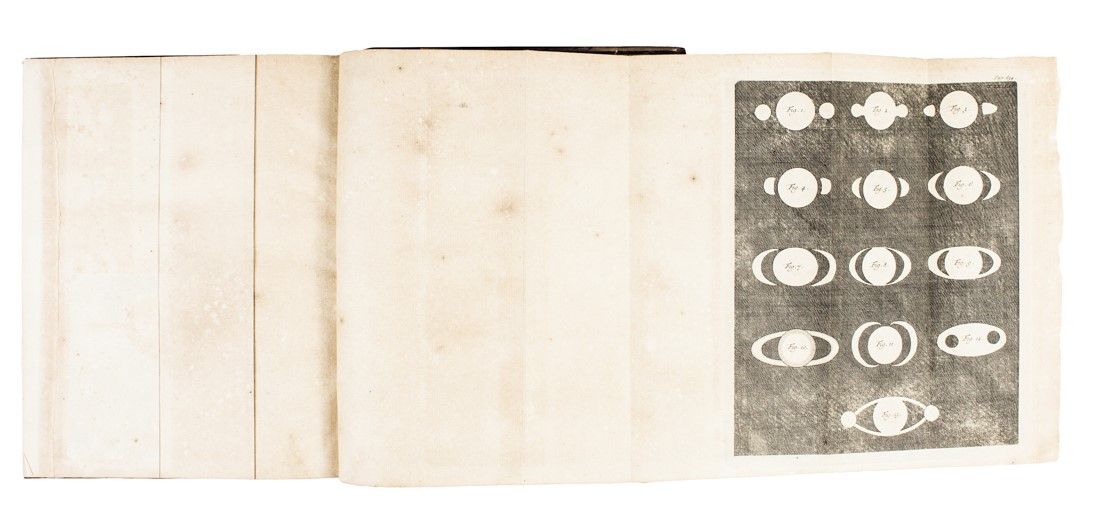HUYGENS, Christiaan. Horologium oscillatorium sive de motu pendulorum ad horologia aptato demonstrationes geometricae. Paris: F. Muguet, 1673.
HUYGENS, Christiaan. Horologium oscillatorium sive de motu pendulorum ad horologia aptato demonstrationes geometricae. Paris: F. Muguet, 1673. 2 o (307 x 198 mm). Ornamental royal armorial woodcut device on title, one full-page woodcut of the pendulum, approximately 100 woodcut diagrams in text, woodcut head- and tail-pieces and initials, leaf a4 shorter. (Title lightly soiled and with two small inkstains, some pale browning.) Contemporary calf (rebacked); quarter morocco folding case. Provenance: Mme. Ve Courcier (bookseller's label); A. Hermann (booklabel); Samuel Verplanck Hoffman (1866-1942), president of the New York Historical Society, member of the Grolier Club, his important collection of astrolabes was acquired by the Smithsonian in 1959 (bookplate). FIRST EDITION OF HUYGENS' MOST IMPORTANT WORK, containing the first mathematical analysis of the motion of the pendulum, and a general treatise on the dynamics of bodies in motion. Huygens constructed the first pendulum clock in 1657, an idea already put forth by Galileo, who had noted the isochronism of the pendulum (its property of swinging in a constant time, regardless of the width of the swing). The idea was a brilliant solution to the problems of keeping time aboard ship, since a reliable time-keeping device was essential for determining longitude, a problem of acute importance in 17th-century Holland, and Huygens' invention, described in the Horologium , was hugely successful--by 1658 pendulums were even applied to the tower clocks of Scheveningen and Utrecht. In the Horologium Huygens broadened his mathematical analysis of the pendulum's movement from a central exposition of the isochronism of the cycloid (a discovery which he had called "the most fortunate finding which ever befell me" [ DSB ]) to a general mathematical discussion of the laws of motion. He focused on the properties of curves, including the theory of the evolutes of curves and the fall of bodies along curves, and determined the first exact value of the intensity of the force of gravity by using a compound pendulum. The treatise "was the most original work of this kind since Galileo's Discorsi .... It ends with 13 theorems (without proofs) on the dynamics of circular motion. Newton in the Principia acknowledges Huygens's priority here, though Huygens's work had little influence on his own" ( PMM ). Reciprocally, while acknowledging the importance of the Principia , Huygens later positioned himself in opposition to Newton, whose theories were irreconciliable with Huygens's adherence to a strictly mechanistic philosophy of the laws of nature. His Horologium was nonetheless "a work of the highest genius which has influenced every science through its mastery of the principles of dynamics. It is second in scientific importance perhaps only to the Principia " (Charles Singer, A Short History of Science to the Nineteenth Century, 1941, p. 258). Dibner Heralds of Science 145; Grolier/Horblit 53; Norman 1137; PMM 154.
HUYGENS, Christiaan. Horologium oscillatorium sive de motu pendulorum ad horologia aptato demonstrationes geometricae. Paris: F. Muguet, 1673.
HUYGENS, Christiaan. Horologium oscillatorium sive de motu pendulorum ad horologia aptato demonstrationes geometricae. Paris: F. Muguet, 1673. 2 o (307 x 198 mm). Ornamental royal armorial woodcut device on title, one full-page woodcut of the pendulum, approximately 100 woodcut diagrams in text, woodcut head- and tail-pieces and initials, leaf a4 shorter. (Title lightly soiled and with two small inkstains, some pale browning.) Contemporary calf (rebacked); quarter morocco folding case. Provenance: Mme. Ve Courcier (bookseller's label); A. Hermann (booklabel); Samuel Verplanck Hoffman (1866-1942), president of the New York Historical Society, member of the Grolier Club, his important collection of astrolabes was acquired by the Smithsonian in 1959 (bookplate). FIRST EDITION OF HUYGENS' MOST IMPORTANT WORK, containing the first mathematical analysis of the motion of the pendulum, and a general treatise on the dynamics of bodies in motion. Huygens constructed the first pendulum clock in 1657, an idea already put forth by Galileo, who had noted the isochronism of the pendulum (its property of swinging in a constant time, regardless of the width of the swing). The idea was a brilliant solution to the problems of keeping time aboard ship, since a reliable time-keeping device was essential for determining longitude, a problem of acute importance in 17th-century Holland, and Huygens' invention, described in the Horologium , was hugely successful--by 1658 pendulums were even applied to the tower clocks of Scheveningen and Utrecht. In the Horologium Huygens broadened his mathematical analysis of the pendulum's movement from a central exposition of the isochronism of the cycloid (a discovery which he had called "the most fortunate finding which ever befell me" [ DSB ]) to a general mathematical discussion of the laws of motion. He focused on the properties of curves, including the theory of the evolutes of curves and the fall of bodies along curves, and determined the first exact value of the intensity of the force of gravity by using a compound pendulum. The treatise "was the most original work of this kind since Galileo's Discorsi .... It ends with 13 theorems (without proofs) on the dynamics of circular motion. Newton in the Principia acknowledges Huygens's priority here, though Huygens's work had little influence on his own" ( PMM ). Reciprocally, while acknowledging the importance of the Principia , Huygens later positioned himself in opposition to Newton, whose theories were irreconciliable with Huygens's adherence to a strictly mechanistic philosophy of the laws of nature. His Horologium was nonetheless "a work of the highest genius which has influenced every science through its mastery of the principles of dynamics. It is second in scientific importance perhaps only to the Principia " (Charles Singer, A Short History of Science to the Nineteenth Century, 1941, p. 258). Dibner Heralds of Science 145; Grolier/Horblit 53; Norman 1137; PMM 154.

.jpg)


.jpg?w=400)
.jpg)


.jpg)




Testen Sie LotSearch und seine Premium-Features 7 Tage - ohne Kosten!
Lassen Sie sich automatisch über neue Objekte in kommenden Auktionen benachrichtigen.
Suchauftrag anlegen